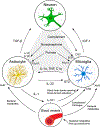Astrocytes and Microglia: In Sickness and in Health
- PMID: 32044129
- PMCID: PMC7472912
- DOI: 10.1016/j.tins.2020.01.003
Astrocytes and Microglia: In Sickness and in Health
Abstract
Healthy central nervous system (CNS) development and function require an intricate and balanced bidirectional communication between neurons and glia cells. In this review, we discuss the complementary roles of astrocytes and microglia in building the brain, including in the formation and refinement of synapses. We discuss recent evidence demonstrating how these interactions are coordinated in the transition from healthy physiology towards disease and discuss known and potential molecular mechanisms that mediate this cellular crosstalk.
Keywords: astrocytes; brain development; microglia; neuroimmune; synapses.
Copyright © 2020 Elsevier Ltd. All rights reserved.
Figures



References
Publication types
MeSH terms
Grants and funding
LinkOut - more resources
Full Text Sources
Other Literature Sources

